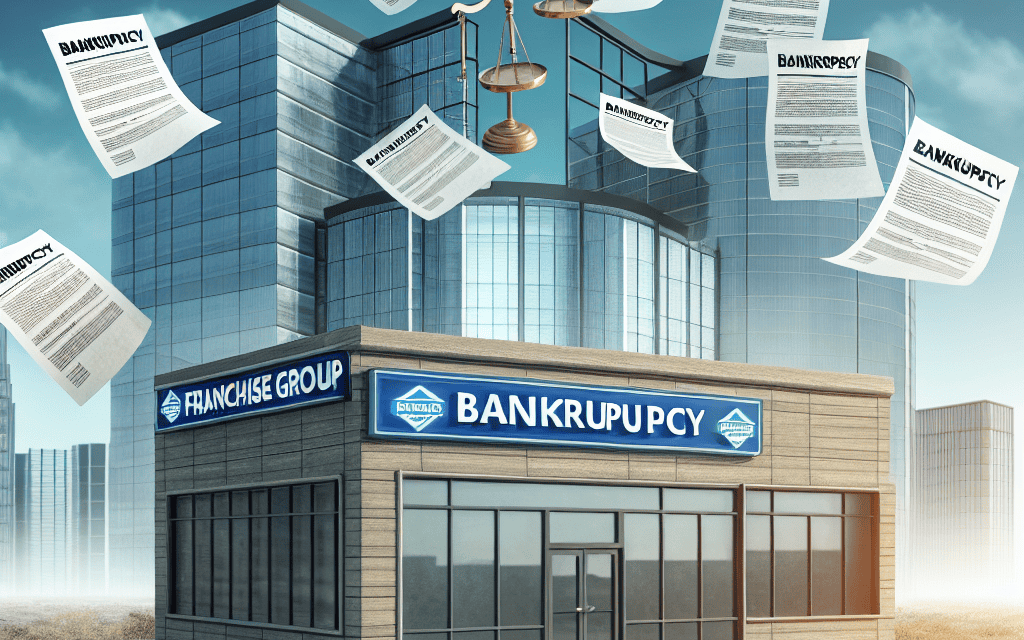“Franchise Group’s Financial Struggle: B. Riley’s Backed Venture Faces Bankruptcy”
Introduction
Franchise Group, a prominent retail holding company, has declared bankruptcy, marking a significant development in the retail sector. Supported by B. Riley Financial, a diversified financial services company, Franchise Group’s decision to file for bankruptcy reflects the challenging economic conditions and operational hurdles it faced. The company, known for owning and managing a diverse portfolio of retail brands, has struggled with declining sales, increased competition, and mounting debt. B. Riley’s involvement highlights the complexities of financial restructuring and the strategic efforts to navigate the bankruptcy process. This move underscores the broader challenges within the retail industry, as companies grapple with evolving consumer behaviors and economic pressures.
Impact Of Bankruptcy On Franchise Group’s Stakeholders
The recent declaration of bankruptcy by the Franchise Group, supported by B. Riley, has sent ripples through its network of stakeholders, raising concerns about the immediate and long-term implications for all parties involved. This development marks a significant turning point for the company, which has been a prominent player in the franchising industry. As the situation unfolds, it is crucial to examine the impact on various stakeholders, including franchisees, employees, creditors, and investors, to understand the broader consequences of this financial upheaval.
To begin with, franchisees are among the most directly affected by the bankruptcy filing. These independent business owners, who have invested significant resources into their franchises, now face an uncertain future. The bankruptcy process may lead to changes in franchise agreements, potentially altering the terms and conditions under which they operate. Franchisees may also experience disruptions in supply chains and support services, which could hinder their ability to maintain business operations. Consequently, this uncertainty may lead to decreased morale and confidence among franchisees, who must now navigate an unpredictable business environment.
In addition to franchisees, employees of the Franchise Group are also grappling with the ramifications of the bankruptcy. The potential for restructuring or downsizing looms large, as the company seeks to streamline operations and reduce costs. This could result in job losses or changes in employment terms for many workers, creating anxiety and instability within the workforce. Moreover, employees may face delays in receiving wages or benefits, further exacerbating their financial concerns. As the company undergoes reorganization, maintaining clear communication with employees will be essential to mitigate the impact on morale and productivity.
Furthermore, creditors of the Franchise Group are closely monitoring the bankruptcy proceedings, as they seek to recover outstanding debts. The bankruptcy filing may lead to negotiations over repayment terms, with creditors potentially having to accept reduced payments or extended timelines. This situation underscores the importance of effective communication and negotiation between the Franchise Group and its creditors to reach mutually agreeable solutions. The outcome of these negotiations will significantly influence the financial health of the creditors and their ability to manage their own obligations.
Investors, too, are feeling the effects of the bankruptcy declaration. The uncertainty surrounding the Franchise Group’s future has likely led to fluctuations in its stock value, impacting investor confidence and portfolio performance. Investors must now reassess their positions and consider the potential risks and rewards of maintaining their investments in the company. The bankruptcy process may also present opportunities for new investors to acquire assets at reduced prices, potentially reshaping the company’s ownership structure.
In light of these challenges, it is imperative for the Franchise Group to develop a comprehensive strategy to address the concerns of its stakeholders. This strategy should prioritize transparent communication, ensuring that all parties are informed of developments and potential outcomes. Additionally, the company must work collaboratively with stakeholders to identify viable solutions that balance the interests of franchisees, employees, creditors, and investors. By doing so, the Franchise Group can navigate the complexities of the bankruptcy process and lay the groundwork for a more stable and sustainable future.
In conclusion, the bankruptcy of the Franchise Group, supported by B. Riley, has far-reaching implications for its stakeholders. Franchisees, employees, creditors, and investors are all facing significant challenges as they adapt to the evolving situation. Through effective communication and strategic planning, the Franchise Group can work towards minimizing the impact on its stakeholders and emerging from bankruptcy with a renewed focus on growth and stability.
Role Of B. Riley In Franchise Group’s Financial Crisis
The recent declaration of bankruptcy by the Franchise Group has sent ripples through the financial community, drawing attention to the intricate role played by B. Riley Financial in this unfolding crisis. As a prominent financial services company, B. Riley has been deeply involved with the Franchise Group, providing both financial backing and strategic guidance. However, the complexities of this relationship have come under scrutiny as the Franchise Group navigates its financial turmoil.
B. Riley’s involvement with the Franchise Group began as a strategic partnership aimed at bolstering the latter’s financial standing. Initially, B. Riley provided critical financial support, including loans and advisory services, to help the Franchise Group expand its operations and stabilize its financial health. This partnership was seen as mutually beneficial, with B. Riley gaining a foothold in the retail sector while the Franchise Group received the necessary capital to pursue growth opportunities.
However, as the Franchise Group’s financial situation began to deteriorate, questions arose regarding the effectiveness of B. Riley’s strategies and the level of risk involved in their financial support. The Franchise Group’s mounting debts and declining revenues highlighted potential missteps in strategic planning and financial management. Despite B. Riley’s efforts to restructure the Franchise Group’s debt and implement cost-cutting measures, the company’s financial woes continued to deepen.
In examining the role of B. Riley in this crisis, it is essential to consider the broader economic context. The retail sector has faced significant challenges in recent years, including shifts in consumer behavior, increased competition from e-commerce, and the lingering effects of the global pandemic. These factors have placed immense pressure on traditional retail businesses, including those within the Franchise Group’s portfolio. B. Riley’s strategies, while well-intentioned, may have been insufficient to counteract these external pressures.
Moreover, the relationship between B. Riley and the Franchise Group raises important questions about the responsibilities of financial advisors and lenders in times of crisis. As a key stakeholder, B. Riley had a vested interest in the Franchise Group’s success. However, the extent to which they were able to influence decision-making and implement effective turnaround strategies remains a point of contention. Critics argue that B. Riley may have underestimated the severity of the Franchise Group’s financial challenges or overestimated the potential for recovery.
As the Franchise Group proceeds through bankruptcy proceedings, the role of B. Riley will likely be scrutinized further. Stakeholders, including creditors and investors, will seek to understand the dynamics of this partnership and the decisions that led to the current situation. This scrutiny may have broader implications for the financial services industry, prompting a reevaluation of how financial advisors and lenders engage with struggling companies.
In conclusion, the bankruptcy of the Franchise Group underscores the complexities and challenges inherent in financial partnerships. While B. Riley’s involvement was initially seen as a stabilizing force, the unfolding crisis highlights the limitations of financial support in the face of broader economic challenges. As the situation continues to evolve, it serves as a cautionary tale for financial institutions and companies alike, emphasizing the need for robust risk assessment and adaptive strategies in an ever-changing economic landscape.
Lessons Learned From Franchise Group’s Bankruptcy
The recent bankruptcy declaration by the Franchise Group, supported by B. Riley, offers a multitude of lessons for businesses navigating the complex landscape of modern commerce. This development underscores the importance of strategic financial management, adaptability, and the need for robust contingency planning. As companies strive to maintain their competitive edge, understanding the factors that led to the Franchise Group’s financial downfall can provide valuable insights for avoiding similar pitfalls.
One of the primary lessons from this bankruptcy is the critical role of financial oversight and prudent investment strategies. The Franchise Group’s reliance on B. Riley for financial backing highlights the necessity of having a solid financial foundation. Companies must ensure that their financial strategies are not overly dependent on external support, which can be precarious in times of economic uncertainty. Instead, businesses should focus on building internal financial resilience through diversified revenue streams and maintaining a healthy balance sheet. This approach can help mitigate risks associated with market fluctuations and unforeseen economic challenges.
Moreover, the Franchise Group’s situation illustrates the importance of adaptability in a rapidly changing business environment. The ability to pivot and adjust business models in response to market demands is crucial for long-term success. Companies must remain vigilant and responsive to shifts in consumer behavior, technological advancements, and competitive pressures. By fostering a culture of innovation and flexibility, businesses can better position themselves to capitalize on emerging opportunities and navigate potential threats.
In addition to financial and strategic adaptability, the Franchise Group’s bankruptcy underscores the significance of effective leadership and governance. Strong leadership is essential for steering a company through turbulent times and making informed decisions that align with the organization’s long-term goals. Leaders must possess the foresight to anticipate challenges and the acumen to implement strategies that safeguard the company’s interests. Furthermore, transparent and accountable governance structures can enhance stakeholder confidence and ensure that the company remains on a sustainable path.
Another critical takeaway from this bankruptcy is the necessity of robust contingency planning. Businesses must be prepared for a range of scenarios, including economic downturns, supply chain disruptions, and shifts in consumer preferences. Developing comprehensive risk management strategies can help companies identify potential vulnerabilities and implement measures to mitigate their impact. This proactive approach can enhance a company’s resilience and enable it to weather adverse conditions more effectively.
Furthermore, the Franchise Group’s experience highlights the importance of maintaining strong relationships with stakeholders, including investors, employees, and customers. Open communication and collaboration with these groups can foster trust and support, which are invaluable during challenging times. By prioritizing stakeholder engagement, companies can build a loyal customer base, attract and retain top talent, and secure the backing of investors who share their vision.
In conclusion, the bankruptcy of the Franchise Group, supported by B. Riley, serves as a cautionary tale for businesses across industries. It emphasizes the need for sound financial management, adaptability, effective leadership, contingency planning, and stakeholder engagement. By learning from these lessons, companies can better equip themselves to navigate the complexities of the modern business landscape and achieve sustainable success. As the business environment continues to evolve, these insights remain crucial for organizations striving to thrive in an increasingly competitive world.
Future Prospects For Franchise Group Post-Bankruptcy

The recent declaration of bankruptcy by the Franchise Group, a company supported by B. Riley Financial, has sent ripples through the business community, raising questions about the future prospects of the organization. As the Franchise Group navigates the complexities of bankruptcy proceedings, stakeholders are keenly observing how the company will restructure and emerge from this financial setback. The bankruptcy filing, while a significant hurdle, also presents an opportunity for the Franchise Group to reassess its business model, streamline operations, and potentially return to profitability.
In the immediate aftermath of the bankruptcy declaration, the Franchise Group is expected to focus on restructuring its debt and negotiating with creditors. This process is crucial as it will determine the company’s ability to stabilize its financial situation and lay the groundwork for future growth. By working closely with B. Riley Financial, the Franchise Group can leverage the expertise and resources of its financial backer to navigate these challenging times. B. Riley’s involvement is likely to play a pivotal role in shaping the company’s post-bankruptcy strategy, providing both financial support and strategic guidance.
As the Franchise Group embarks on this journey, one of the key areas of focus will be the evaluation of its existing franchise operations. This evaluation will involve a thorough analysis of the performance of individual franchises, identifying those that are underperforming and determining the reasons behind their struggles. By addressing these issues, the Franchise Group can make informed decisions about which franchises to retain, restructure, or divest. This strategic pruning of the franchise portfolio is essential for the company to concentrate its resources on the most promising and profitable ventures.
Moreover, the Franchise Group’s post-bankruptcy strategy will likely include efforts to enhance operational efficiency across its franchise network. This could involve implementing new technologies, optimizing supply chain management, and improving customer service standards. By focusing on these areas, the company can create a more robust and competitive franchise system that is better equipped to meet the demands of the market. Additionally, the Franchise Group may explore opportunities to expand into new markets or introduce innovative products and services, thereby diversifying its revenue streams and reducing reliance on any single segment.
Another critical aspect of the Franchise Group’s future prospects is the potential to attract new investors and partners. The bankruptcy process, while challenging, can also serve as a catalyst for change, prompting the company to adopt a more transparent and accountable approach to its operations. By demonstrating a commitment to restructuring and growth, the Franchise Group can rebuild trust with existing stakeholders and attract new investment. This influx of capital and expertise can provide the necessary resources to support the company’s long-term objectives and drive sustainable growth.
In conclusion, while the bankruptcy declaration marks a difficult chapter for the Franchise Group, it also presents an opportunity for renewal and transformation. By focusing on debt restructuring, operational efficiency, and strategic growth, the company can position itself for a successful post-bankruptcy future. With the support of B. Riley Financial and a clear vision for the future, the Franchise Group has the potential to emerge from this challenging period stronger and more resilient than before. As the company navigates this complex process, stakeholders will be watching closely to see how it capitalizes on these opportunities and charts a path toward recovery and success.
Legal Implications Of Franchise Group’s Bankruptcy Filing
The recent bankruptcy filing by the Franchise Group, supported by B. Riley Financial, has sent ripples through the business and legal communities, raising numerous questions about the implications for stakeholders involved. This development underscores the complex interplay between financial backing and corporate solvency, highlighting the intricate legal landscape that companies must navigate when facing financial distress. As the Franchise Group embarks on this challenging journey, it is essential to examine the legal ramifications of their bankruptcy filing and the potential consequences for creditors, employees, and other stakeholders.
To begin with, the bankruptcy filing initiates a legal process that aims to reorganize the Franchise Group’s debts and obligations. This process is governed by federal bankruptcy laws, which provide a structured framework for companies to address their financial difficulties while attempting to remain operational. The involvement of B. Riley Financial, a prominent investment bank and financial services company, adds another layer of complexity to the proceedings. B. Riley’s support may influence the restructuring plan, as they hold significant financial interests in the Franchise Group’s future viability.
One of the primary legal implications of the bankruptcy filing is the automatic stay provision, which halts all collection activities by creditors. This provision is designed to provide the Franchise Group with breathing room to develop a reorganization plan without the immediate threat of asset seizures or lawsuits. However, this also means that creditors must navigate the bankruptcy court system to assert their claims, potentially leading to protracted legal battles over the prioritization and repayment of debts. The court will play a crucial role in determining the order in which creditors are paid, often prioritizing secured creditors over unsecured ones.
Moreover, the bankruptcy filing raises concerns about the fate of the Franchise Group’s employees. Under bankruptcy law, employee wages and benefits are typically given priority in the repayment hierarchy. However, the uncertainty surrounding the company’s financial future may lead to workforce reductions or changes in employment terms. This situation necessitates careful legal consideration to ensure compliance with labor laws and to mitigate potential disputes with employees or labor unions.
In addition to creditors and employees, the Franchise Group’s bankruptcy has implications for its franchisees. Franchise agreements are complex legal contracts that outline the rights and responsibilities of both the franchisor and franchisee. The bankruptcy filing may trigger clauses within these agreements, potentially leading to renegotiations or terminations. Franchisees must be vigilant in understanding their legal rights and obligations during this period of uncertainty, as their businesses could be significantly impacted by the outcome of the bankruptcy proceedings.
Furthermore, the involvement of B. Riley Financial in the bankruptcy process may influence the strategic direction of the Franchise Group’s reorganization efforts. As a key financial backer, B. Riley may advocate for specific restructuring strategies that align with their interests, potentially affecting the overall outcome of the bankruptcy case. This dynamic underscores the importance of transparency and communication among all parties involved to ensure a fair and equitable resolution.
In conclusion, the Franchise Group’s bankruptcy filing, supported by B. Riley Financial, presents a multifaceted legal challenge with far-reaching implications for creditors, employees, franchisees, and other stakeholders. As the legal proceedings unfold, it will be crucial for all parties to navigate the complexities of bankruptcy law with diligence and foresight, striving for a resolution that balances the interests of all involved while paving the way for the Franchise Group’s potential recovery.
Analysis Of Franchise Group’s Business Model And Its Failures
The recent bankruptcy declaration by the Franchise Group, supported by B. Riley, has sent ripples through the business community, prompting a closer examination of the company’s business model and the factors contributing to its downfall. The Franchise Group, known for its diverse portfolio of retail and service-oriented businesses, had initially positioned itself as a robust player in the franchising sector. However, despite its ambitious expansion strategies and the backing of financial services firm B. Riley, the company ultimately succumbed to a series of operational and strategic missteps.
At the core of the Franchise Group’s business model was the acquisition and management of various franchise brands, spanning industries such as retail, health, and consumer services. This diversification strategy was intended to mitigate risks by spreading investments across different sectors. However, while diversification can be a strength, it also requires adept management and a deep understanding of each industry’s unique challenges. The Franchise Group’s failure to effectively integrate and manage its diverse portfolio became increasingly apparent as operational inefficiencies and inconsistent brand performances emerged.
One significant issue was the lack of synergy among the acquired brands. The Franchise Group’s approach often involved acquiring underperforming or distressed assets with the aim of revitalizing them. However, this strategy necessitated substantial capital investment and a coherent turnaround plan, both of which appeared to be lacking. The absence of a unified operational framework led to fragmented management practices, which in turn resulted in inconsistent customer experiences and brand dilution. Consequently, the anticipated synergies and cost efficiencies failed to materialize, eroding the company’s profitability.
Moreover, the Franchise Group’s aggressive expansion strategy, while initially promising, ultimately proved unsustainable. The rapid pace of acquisitions strained the company’s financial resources and diverted attention from optimizing existing operations. This expansion was further complicated by the evolving retail landscape, characterized by shifting consumer preferences and the growing dominance of e-commerce. The Franchise Group’s inability to adapt to these changes, coupled with its reliance on traditional brick-and-mortar models, left it vulnerable to market disruptions.
In addition to operational challenges, the Franchise Group faced financial hurdles that exacerbated its difficulties. Despite the support of B. Riley, which provided financial backing and advisory services, the company’s mounting debt levels and declining cash flows became insurmountable. The reliance on debt financing to fuel acquisitions and sustain operations created a precarious financial position, leaving the company with limited flexibility to navigate economic downturns or invest in necessary innovations.
Furthermore, the Franchise Group’s leadership faced criticism for its strategic decisions and lack of transparency. Stakeholders expressed concerns over the company’s governance practices and the effectiveness of its leadership team in steering the organization through turbulent times. This erosion of trust among investors and partners further compounded the company’s challenges, ultimately contributing to its decision to file for bankruptcy.
In conclusion, the bankruptcy of the Franchise Group underscores the complexities and risks inherent in managing a diversified franchise portfolio. While diversification and expansion can offer growth opportunities, they require meticulous planning, effective integration, and a keen understanding of market dynamics. The Franchise Group’s experience serves as a cautionary tale for businesses seeking to navigate the intricate landscape of franchising, highlighting the importance of strategic coherence, operational efficiency, and financial prudence in achieving sustainable success.
Strategies For Recovery After Franchise Group’s Bankruptcy
The recent declaration of bankruptcy by the Franchise Group, a company supported by B. Riley Financial, has sent ripples through the business community, prompting stakeholders to consider strategies for recovery and future stability. This development underscores the importance of strategic planning and adaptive measures in navigating financial distress. As the Franchise Group embarks on the path to recovery, several strategies can be employed to mitigate the impact of bankruptcy and lay the groundwork for a more resilient future.
To begin with, a comprehensive assessment of the company’s financial health is crucial. This involves a thorough analysis of assets, liabilities, and cash flow to identify areas of concern and potential opportunities for cost reduction. By understanding the financial landscape, the Franchise Group can prioritize debt restructuring and negotiate with creditors to establish more manageable repayment terms. This step not only alleviates immediate financial pressure but also fosters a cooperative relationship with creditors, which is essential for long-term recovery.
In addition to financial restructuring, operational efficiency must be addressed. Streamlining operations by eliminating redundancies and optimizing supply chain processes can significantly reduce costs and improve profitability. This may involve adopting new technologies or revisiting existing business models to enhance productivity. By focusing on core competencies and shedding non-essential operations, the Franchise Group can concentrate resources on areas with the highest potential for growth and profitability.
Moreover, the importance of leadership and management cannot be overstated in times of crisis. Effective leadership is pivotal in steering the company through turbulent waters. This involves not only making difficult decisions but also inspiring confidence among employees, investors, and other stakeholders. Transparent communication about the company’s challenges and recovery plans can help maintain trust and morale, which are vital for successful turnaround efforts.
Furthermore, exploring new revenue streams and market opportunities can provide a much-needed boost to the Franchise Group’s recovery efforts. Diversification into new markets or product lines can mitigate risks associated with over-reliance on a single source of income. This strategy requires careful market research and a willingness to innovate, ensuring that new ventures align with the company’s strengths and market demand.
In parallel, customer retention and satisfaction should remain a top priority. Maintaining strong relationships with existing customers can provide a stable revenue base during the recovery phase. Implementing loyalty programs, enhancing customer service, and actively seeking feedback can help retain customer trust and encourage repeat business. Additionally, leveraging digital marketing and social media platforms can expand the company’s reach and attract new customers, further supporting revenue growth.
Finally, learning from past mistakes is essential for sustainable recovery. Conducting a post-mortem analysis of the factors that led to bankruptcy can provide valuable insights and prevent similar issues in the future. This reflective process should be integrated into the company’s strategic planning, ensuring that lessons learned inform future decision-making and risk management practices.
In conclusion, while the bankruptcy of the Franchise Group presents significant challenges, it also offers an opportunity for reinvention and growth. By focusing on financial restructuring, operational efficiency, leadership, market diversification, customer retention, and learning from past experiences, the company can navigate its way toward recovery. These strategies, when implemented effectively, can not only stabilize the Franchise Group but also position it for long-term success in an ever-evolving business landscape.
Q&A
1. **What is Franchise Group?**
Franchise Group is a publicly traded company that owns and operates a variety of franchise businesses across different sectors, including retail, health, and wellness.
2. **Who is B. Riley?**
B. Riley Financial is a diversified financial services company that provides investment banking, financial advisory, and asset management services.
3. **Why did Franchise Group declare bankruptcy?**
Franchise Group declared bankruptcy due to financial difficulties, which may include declining sales, high debt levels, or operational challenges.
4. **What role did B. Riley play in the bankruptcy?**
B. Riley may have acted as a financial advisor or provided financial support to Franchise Group during the bankruptcy process.
5. **What are the implications of the bankruptcy for Franchise Group?**
The bankruptcy allows Franchise Group to restructure its debts, potentially close underperforming locations, and reorganize its business operations to regain financial stability.
6. **How does the bankruptcy affect franchisees?**
Franchisees may face uncertainty regarding their operations, potential changes in franchise agreements, or support from the parent company during the restructuring process.
7. **What is the potential outcome of the bankruptcy?**
The potential outcome could include a successful reorganization and emergence from bankruptcy, sale of assets, or liquidation if restructuring efforts fail.
Conclusion
Franchise Group, supported by B. Riley, declaring bankruptcy signifies a significant financial and operational setback for the company. This development likely stems from a combination of factors such as unsustainable debt levels, declining revenues, or operational inefficiencies. The involvement of B. Riley, a financial services firm, suggests that efforts were made to stabilize or restructure the company before resorting to bankruptcy. This move will likely lead to a reorganization of the company’s assets and liabilities under court supervision, impacting stakeholders including employees, creditors, and franchisees. The bankruptcy declaration underscores the challenges faced by franchise-based businesses in maintaining financial health amidst changing market conditions.





